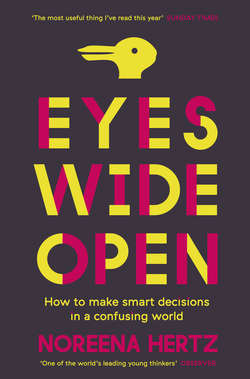Читать книгу Eyes Wide Open: How to Make Smart Decisions in a Confusing World - Noreena Hertz - Страница 27
QUICK TIPS FOR SEEING THE TIGER AND THE SNAKE
Оглавление• Look beyond the most obvious data. What you are most drawn to will not necessarily be most relevant. Ask yourself what additional information might be of use. Challenge yourself to think about what you might have missed.
• Practise becoming more observant. Introduce a regular mindfulness technique to your day, such as the ‘raisin practice’. This will have a tangible effect on the quality of your decisions.
• Remember that numbers only tell a partial story. What are the numbers not telling you? What other information do you need to consider?
• Be aware of the form in which you’re receiving your information. Is it too reductionist? What is the PowerPoint slide not revealing? What is the Executive Summary not telling you? Who can provide you with the requisite nuance or detail? Is there a more in-depth report you need to get your hands on? If so, can you set the requisite time aside to read it and properly absorb the information?
• Don’t confuse a generally happy disposition with unrealistic levels of optimism. When you’re next told that something bad could happen to you, remind yourself of our natural tendency to ignore or underplay this kind of news. Try to contemplate whether your assessment would be different if you took your optimism down a notch or two. Who around you is of the glass-half-empty mindset? They might have a more realistic take on the information. Are you touching base with them frequently enough?
• Don’t just seek out information that confirms what it is you already believe or think. It’s vital to actively seek out information that could prove you wrong. Who in your life can act as your ‘Challenger in Chief’ to remind you to do this?
• As a general rule, carve out more thinking time for yourself. If Barack Obama can prioritise this, so can you. Can you batch your emails so as to free up thinking time? Schedule thinking time into your diary as you would any other appointment? What on your to-do list can be postponed or ditched?
• Slow down, to avoid making thinking errors. Give yourself time to consider alternative diagnoses and possibilities. We risk accepting the most easy-to-reach answer because we are so rushed for time. Develop a strategy that helps you avoid this. For some it may be a checklist, for others it may be that Challenger in Chief to talk the options through with.
• Identify those day-to-day distractions which take up too much of your focus. Can you limit the number of times you check Facebook or the football scores? How about downloading software that stops you from being able to surf the web for specified periods?
• Don’t use the past as too fixed a steer. There is great danger in assuming that the past will light the way to the future. Think of your favourite Dick Zanuck movie, or that special magician from Hogwarts, as a way of avoiding this thinking error.
• Have Plans B, C and D in your back pocket, and be willing to change tack. Accept the fast-moving nature of our world and how quickly things can change. This demands that we monitor our landscape on an ongoing basis.
• Where possible, don’t make big decisions way before you actually need to. Make your decisions as late in the day as you can, so that you can take into account the hyper-rapid changing nature of our world.
• Stretch yourself to imagine the unimaginable. What might future scenarios look like? How might circumstances change? How might they differ from right now? And how does this impact your thinking and the decisions you should make?
• Accept that not all outcomes can be anticipated. What can you put in place to mitigate worst-case scenarios? Can you buy insurance? Hedge your decision?
• Don’t allow success to make you complacent, or failure to define you. Recognise the transient nature of both, and that learning opportunities can arise from either.
